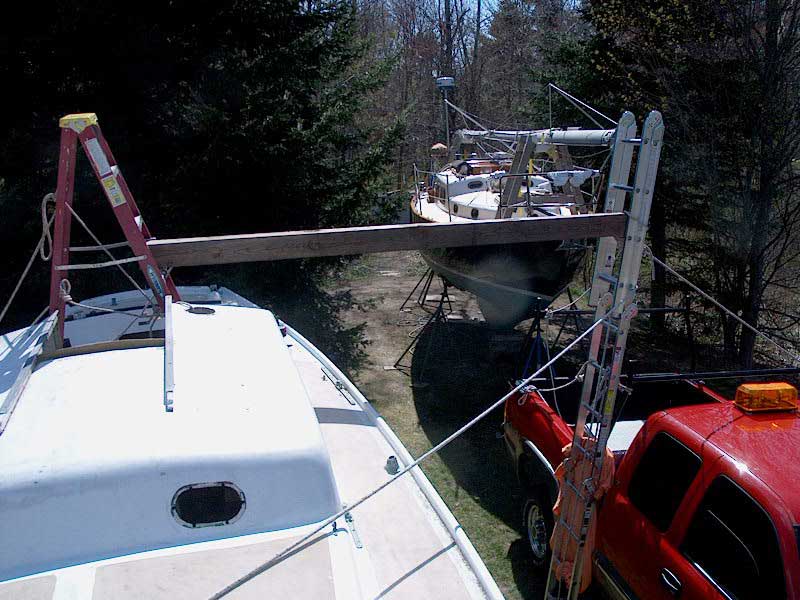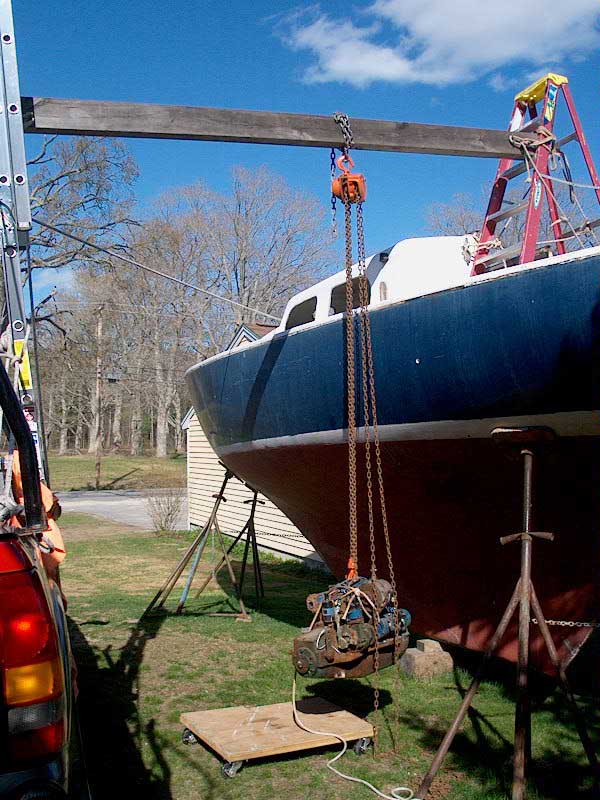|
| |
May 10, 2003
On (finally) a hot, sunny
afternoon, I decided to tackle getting the Atomic 4 off the boat once and
for all. With it already sitting in the cockpit, it only needed to
be lowered 10 feet to the ground. However, this is always a somewhat
tricky procedure, since it usually involves some sort of rickety and
cobbed-together hoisting arrangement that has to be partially on the boat,
and partially on the ground. It certainly helped in this instance to
not be worried about scarring the deck, or even the hull; this is a much
more precise operation when the boat from which you are removing an engine
is finished and in good condition.
Because the boat is, in its
current location, leaning rather dramatically to starboard, I decided to
lower the engine off the port side. Plus, for this particular event,
I wanted to use my truck as a support for a ladder that I would erect on
that side--there was no truck access to the starboard side. So,
first, I slid the engine across the cockpit to the other side. I
salvaged the icebox lid from Glissando to cover the cockpit ice
hatch and allow me to place the engine there. It's amazing how easy
(relatively) it is to slide these engines around with no mechanical
advantage.
I installed a 6' fiberglass
stepladder in the cockpit, its legs spanning the cockpit well. I
tied it in position. To form the other side of my hoist, I backed my
truck up next to the boat and then arranged one of my 16' extension
ladders against the truck, sticking up in the air and tied in place with
several lines, including a critical one that passed beneath the truck and
held the bottom of the ladder from sliding out. I tied on some extra
lines as overkill; it never hurts.
  Next,
I took my 4x6, 10' long beam and ran it between the two ladders, at a
height that seemed appropriate. Of course, I discovered that the
truck should have been about a foot closer to the boat--the beam just
reached and seemed precarious. With the ladder all tied nine ways to
Sunday on the truck, moving the truck was an unpopular option.
Instead, I found a couple pieces of hardware in my shop, which I screwed
to the beam (one on each end) and used to tie the beam to each ladder, to
prevent it from slipping off the rungs in either direction. The
nature of hauling engines over the side is such that there is almost
always an angled load on the beam, which would tend to pull it one way or
the other. I hoped the lines would prevent this. Next,
I took my 4x6, 10' long beam and ran it between the two ladders, at a
height that seemed appropriate. Of course, I discovered that the
truck should have been about a foot closer to the boat--the beam just
reached and seemed precarious. With the ladder all tied nine ways to
Sunday on the truck, moving the truck was an unpopular option.
Instead, I found a couple pieces of hardware in my shop, which I screwed
to the beam (one on each end) and used to tie the beam to each ladder, to
prevent it from slipping off the rungs in either direction. The
nature of hauling engines over the side is such that there is almost
always an angled load on the beam, which would tend to pull it one way or
the other. I hoped the lines would prevent this.

|
|
  With
the beam in place, tightly tied, and both ladders secured, it looked like
I was ready. I set up the chain hoist roughly above the engine--and
a little outboard, so I could pull the engine sideways onto the raised
coaming outside the cockpit as well as lift it. Carefully, I
put a load on the hoist, slowly testing the entire lifting rig and ladder
arrangements. Everything held, and the beam seemed to be holding
properly in position with no sliding. IN one step, I raised the
engine up and forced it onto the coaming. Now I needed to reset the
hoist a bit further outboard, so that I could carefully pull the engine up
and over the side. With
the beam in place, tightly tied, and both ladders secured, it looked like
I was ready. I set up the chain hoist roughly above the engine--and
a little outboard, so I could pull the engine sideways onto the raised
coaming outside the cockpit as well as lift it. Carefully, I
put a load on the hoist, slowly testing the entire lifting rig and ladder
arrangements. Everything held, and the beam seemed to be holding
properly in position with no sliding. IN one step, I raised the
engine up and forced it onto the coaming. Now I needed to reset the
hoist a bit further outboard, so that I could carefully pull the engine up
and over the side.
|
|
  After
moving the hoist outboard several inches, I was ready for the final--and
most nerve wracking--part of the lift. At this stage, I had to not
only lift the engine high enough to get over the toerail, but also swing
it sideways and over the side, where it could be lowered to the
ground. This is the trickiest part of the job, since there is
the risk of the engine suddenly shifting from partially supported by the
boat to not at all, and this sort of shock loading could cause problems
with the lifting arrangement, ladders, or beam. This was something
that I preferred to avoid. To help control the engine's swing when
it finally became free of the deck, I attached a control line. After
moving the hoist outboard several inches, I was ready for the final--and
most nerve wracking--part of the lift. At this stage, I had to not
only lift the engine high enough to get over the toerail, but also swing
it sideways and over the side, where it could be lowered to the
ground. This is the trickiest part of the job, since there is
the risk of the engine suddenly shifting from partially supported by the
boat to not at all, and this sort of shock loading could cause problems
with the lifting arrangement, ladders, or beam. This was something
that I preferred to avoid. To help control the engine's swing when
it finally became free of the deck, I attached a control line.
|
|
Carefully, I increased tension on the hoist, while at the same time
helping the engine slide over the side and holding it from too much sudden
movement with my control line. Of course, just as I needed about 1-2
more inches of clearance, the hoist became two-blocked, preventing me from
lifting any more. This always seems to happen! The
reason it happened this time was that, as mentioned earlier, the beam was
barely long enough to reach from the rungs on which it was resting, and
raising it to the next rung on the stepladder on the boat---which, of
course, is angled slightly further away--would have meant that the beam
wouldn't have reached at all.
|
|
 With
some very gentle persuasion, and holding the control line tightly, I
pushed and grunted the engine oh-so-carefully over the toerail and finally
got it to a point where it was hanging free. Noting how much the flimsy
cockpit seat was distorted by the ladder, and not particularly feeling
like having a problem, I lowered the engine to the ground as quickly as
possible, setting it on my little homemade plywood dolly. With
some very gentle persuasion, and holding the control line tightly, I
pushed and grunted the engine oh-so-carefully over the toerail and finally
got it to a point where it was hanging free. Noting how much the flimsy
cockpit seat was distorted by the ladder, and not particularly feeling
like having a problem, I lowered the engine to the ground as quickly as
possible, setting it on my little homemade plywood dolly.
|
|


|

|
|
Using some 1/4"
plywood scrap that I had around, I managed to roll the dolly across the
lawn and into the garage, where the engine will remain for the time being.
The engine removal is
complete! |
|











